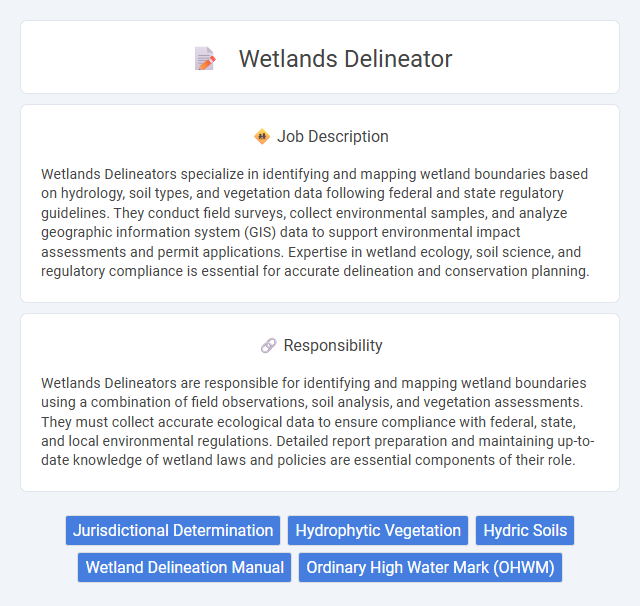
Wetlands Delineators specialize in identifying and mapping wetland boundaries based on hydrology, soil types, and vegetation data following federal and state regulatory guidelines. They conduct field surveys, collect environmental samples, and analyze geographic information system (GIS) data to support environmental impact assessments and permit applications. Expertise in wetland ecology, soil science, and regulatory compliance is essential for accurate delineation and conservation planning.
People with a strong interest in environmental science and fieldwork will likely find a Wetlands Delineator position suitable. Individuals comfortable with outdoor conditions, variable weather, and physical activity may have a higher probability of thriving in this role. Those who prefer stable office environments might be less compatible, as the job often requires on-site assessments and data collection in diverse wetland areas.
Qualification
A Wetlands Delineator must possess extensive knowledge of hydric soils, hydrophytic vegetation, and wetland hydrology to accurately identify and map wetland boundaries. Candidates typically require a degree in environmental science, ecology, or a related field, alongside certifications such as the Certified Wetland Scientist (CWS) or training in the U.S. Army Corps of Engineers Wetland Delineation Manual. Proficiency in field data collection, GIS mapping technology, and regulatory compliance under the Clean Water Act is essential for effective job performance.
Responsibility
Wetlands Delineators are responsible for identifying and mapping wetland boundaries using a combination of field observations, soil analysis, and vegetation assessments. They must collect accurate ecological data to ensure compliance with federal, state, and local environmental regulations. Detailed report preparation and maintaining up-to-date knowledge of wetland laws and policies are essential components of their role.
Benefit
Wetlands delineators likely experience benefits such as gaining specialized expertise in environmental regulations and habitat assessment, which can enhance their career prospects. This role probably offers opportunities for fieldwork in diverse ecosystems, promoting both professional growth and personal fulfillment. The job may also provide a chance to contribute directly to conservation efforts, benefiting ecological sustainability and community health.
Challenge
The job of a Wetlands Delineator likely involves navigating complex environmental regulations and accurately identifying wetland boundaries under varying field conditions. Challenges may stem from interpreting ambiguous ecological data and adapting to seasonal changes that affect wetland indicators. Precision in mapping and documentation is critical, as mistakes could lead to regulatory setbacks or environmental harm.
Career Advancement
A career as a Wetlands Delineator offers significant opportunities for advancement through gaining expertise in wetland ecology, environmental regulations, and GIS technology. Professionals can progress to senior environmental consultant roles, project management, or specialize in regulatory compliance and habitat restoration. Certification through organizations such as the Society of Wetland Scientists enhances credentials and opens doors to leadership positions and higher-level environmental planning jobs.
Key Terms
Jurisdictional Determination
A Wetlands Delineator specializes in identifying and mapping wetland boundaries to assist in Jurisdictional Determination under the Clean Water Act. This role involves detailed field assessments of soil, vegetation, and hydrology to establish whether an area meets federal jurisdiction criteria. Accurate delineation supports regulatory compliance and informs land use planning, conservation efforts, and environmental permitting processes.
Hydrophytic Vegetation
A Wetlands Delineator specializing in hydrophytic vegetation identifies and maps plant species indicative of saturated soil conditions essential for wetland boundaries. Expertise in plant morphology, soil saturation patterns, and regional hydrology is crucial to distinguish hydrophytic vegetation from upland species accurately. Accurate delineation influences wetland conservation, regulatory compliance with the Clean Water Act, and environmental impact assessments.
Hydric Soils
A Wetlands Delineator specializes in identifying and mapping wetland boundaries by analyzing hydric soils, which are crucial indicators of saturated conditions needed for wetland ecosystems. Expertise in hydric soil morphology, such as color patterns, redoximorphic features, and organic content, ensures accurate wetland delineation compliant with U.S. Army Corps of Engineers standards. Proficiency in soil sampling techniques and interpretation of USDA soil surveys enhances the precision of wetland assessments for environmental permitting and conservation projects.
Wetland Delineation Manual
Wetlands delineators use the Wetland Delineation Manual to accurately identify and map wetland boundaries based on hydrology, vegetation, and soil criteria. This manual, developed by the U.S. Army Corps of Engineers, provides standardized protocols essential for preparing regulatory compliance reports and environmental impact assessments. Expertise in applying the manual's procedures ensures precise classification and protection of wetland ecosystems under federal and state regulations.
Ordinary High Water Mark (OHWM)
A Wetlands Delineator identifies and maps wetland boundaries by analyzing physical indicators such as the Ordinary High Water Mark (OHWM), which signifies the line where water regularly saturates soil or leaves visible marks on vegetation and substrate. Accurate determination of the OHWM is crucial for defining jurisdictional wetlands under the Clean Water Act, requiring expertise in soil science, hydrology, and vegetation patterns. Wetlands Delineators use OHWM indicators including sediment deposits, water staining, and changes in vegetation to ensure regulatory compliance and environmental protection.
 kuljobs.com
kuljobs.com